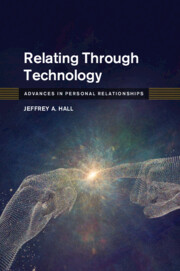Book contents
- Relating Through Technology
- Advances in Personal Relationships
- Relating Through Technology
- Copyright page
- Dedication
- Contents
- Figures
- Tables
- Introduction
- 1 Social Ecology and Personal Media
- 2 The Social Construction of Technology
- 3 Theoretical Perspectives on Personal Media and Relationships
- 4 Niche, Media Displacement, and Multimodal Relationships
- 5 Mode Comparison and Coexistence
- 6 Three Ways of Seeing Social Media
- 7 Five Enduring Tensions in Personal Media
- 8 Digital Stress
- 9 Social Displacement
- 10 Connectivity and Connection
- References
- Index
7 - Five Enduring Tensions in Personal Media
Published online by Cambridge University Press: 26 June 2020
- Relating Through Technology
- Advances in Personal Relationships
- Relating Through Technology
- Copyright page
- Dedication
- Contents
- Figures
- Tables
- Introduction
- 1 Social Ecology and Personal Media
- 2 The Social Construction of Technology
- 3 Theoretical Perspectives on Personal Media and Relationships
- 4 Niche, Media Displacement, and Multimodal Relationships
- 5 Mode Comparison and Coexistence
- 6 Three Ways of Seeing Social Media
- 7 Five Enduring Tensions in Personal Media
- 8 Digital Stress
- 9 Social Displacement
- 10 Connectivity and Connection
- References
- Index
Summary
This chapter argues that there are five enduring tensions in the use of media in relationships: hyper-coordination versus micro-coordination, personalized and purposeful messages versus generalized messages, contributing to the conversation versus virtual people watching, intentional attention versus incidental awareness, and routine access offline versus limited access offline. Each of these tensions describes how to conceptualize and understand the different ways of using personal media for social interaction and communication. These tensions are presented as dialectical tensions.
Keywords
- Type
- Chapter
- Information
- Relating Through TechnologyEveryday Social Interaction, pp. 135 - 156Publisher: Cambridge University PressPrint publication year: 2020

